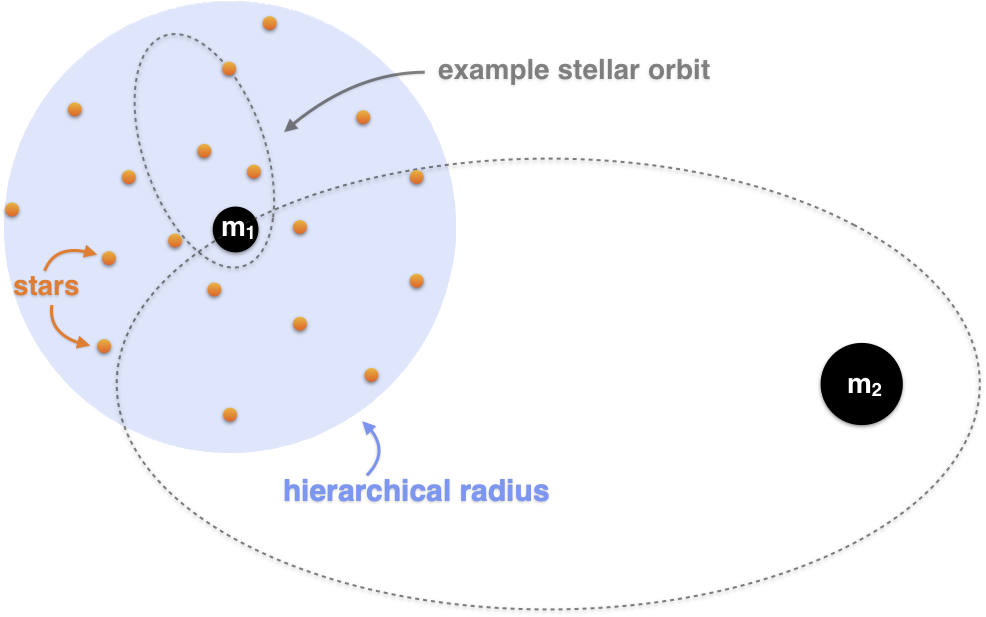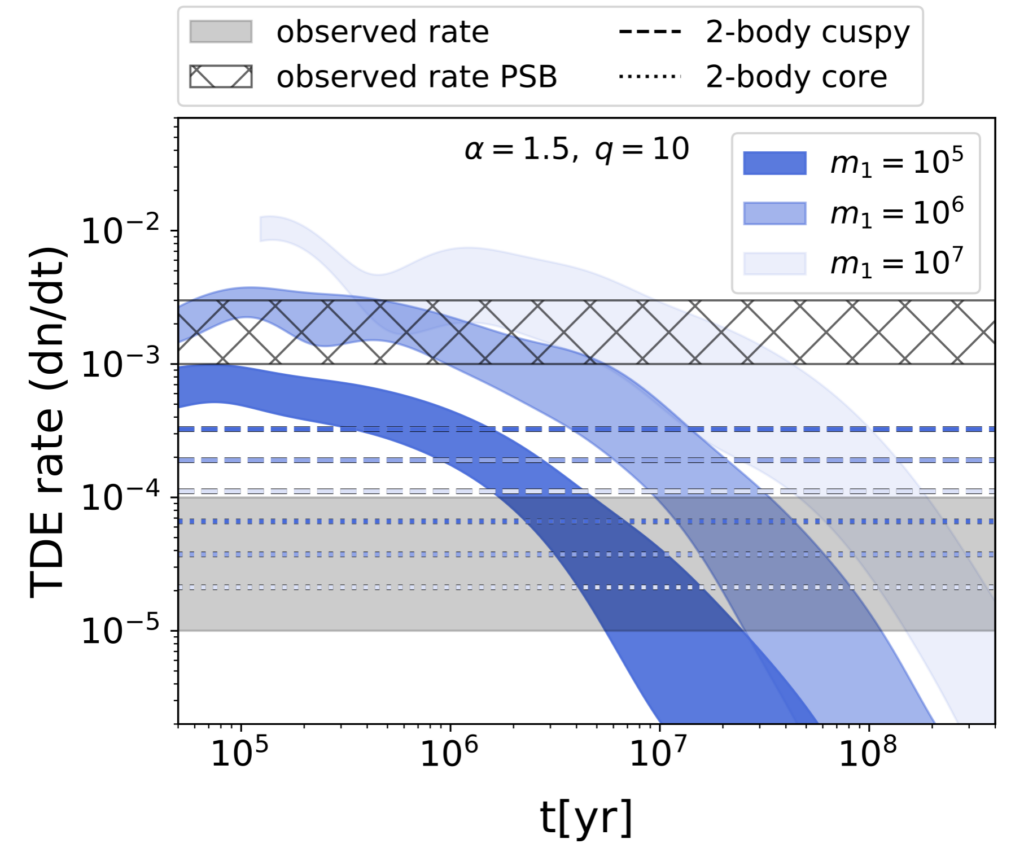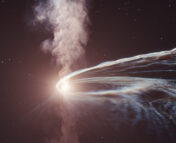Title: Uncovering Hidden Massive Black Hole Companions with Tidal Disruption Events
Authors: Brenna Mockler, Denyz Melchor, Smadar Naoz, Enrico Ramirez-Ruiz
First Author’s Institution: The Observatories of the Carnegie Institution for Science & Department of Physics and Astronomy at UCLA
Status: Submitted to ApJ [open access]
Two is Company
Today, astronomers believe that every galaxy hosts a supermassive black hole (SMBH) at its center. In addition, galaxies are thought to grow through mergers, in a process known as hierarchical growth. Essentially, smaller galaxies smash together to form a larger galaxy, and this cycle repeats, many times, as the universe evolves. When two galaxies hosting SMBHs merge together, the SMBHs should both sink to the center of the new galaxy rather rapidly, where they could start orbiting each other as a SMBH binary. These SMBH binaries are therefore a natural consequence of this picture of hierarchical galaxy evolution and should be a relatively common occurrence in the universe.
However, finding SMBH binaries has been rather difficult with current instrumentation and technology. As the black holes get closer and closer together, our telescopes become incapable of resolving them as two individual black holes. There are other ways to infer that a binary exists when the black holes are close together, but these methods can be tricky — either the signals could also be produced by some other astrophysical phenomenon, or they take decades to confirm. The next generation of gravitational wave detectors, like LISA, will surely help, but we’d still like to be able to look for SMBH binaries in the next decade or more before these detectors are built!
Introducing: The Star of The Show
One of the best ways to observe something we can’t see is by looking for its interactions with things we can see. Today’s authors study the interplay of a SMBH binary with stars in the centers of galaxies, highlighting this as a potential way to uncover SMBH binaries. To start, let’s consider just a single SMBH and throw a star at it. Most of the time, this star will orbit around the black hole, just like our planets orbit around the Sun. However, in some cases when the orbit is eccentric enough, the star can get just a bit too close to the SMBH, leading to its demise. This measure of “too close” is set by the distance at which the star’s self-gravity can no longer hold itself together against the tidal forces of the SMBH, and the star gets ripped to shreds. We call this phenomenon a tidal disruption event (TDE), and these events release a huge amount of energy from a previously quiet black hole.
Okay, but how do we get stars onto these elliptical orbits so that they’re disrupted? And how often does this happen? Many papers have investigated these questions (check out some of the many Astrobites written on TDEs), both from a theoretical and observational perspective. It turns out that one way to get stars onto these highly elliptical orbits is to scatter them off of the other nearby stars (through a process called two-body relaxation). This process is relatively rare; both theory and observations agree that the rate for TDEs around single black holes is somewhere around 1 every 104-105 years (per galaxy).
But what happens when we deposit these stars around a SMBH binary? The authors of today’s paper investigate this very question. In particular, they investigate the interaction of stars around the smaller of the two black holes (see Figure 1 for a schematic of this set up).

And Now Three’s a Crowd
To explore the effects of a binary SMBH on the rate of TDEs, the authors perform dynamical simulations of the three-body problem we just set up above. They focus in particular on the effects of the eccentric Kozai-Lidov (EKL) mechanism, which is a dynamical effect in a three-body system that allows the eccentricity and inclination of the outer binary (i.e. the star and the lower mass black hole) to oscillate. EKL can lead to extreme eccentricities, which is a great way to make TDEs! To explore the effects of EKL on the system, the authors test different combinations of binary masses and stellar density profiles. There’s a large range of possible parameters in this problem, so they limit their tests to those in which the timescale for the EKL mechanism is the shortest dynamical timescale (which leads to EKL being the dominant mechanism driving the system’s evolution).
The simulations revealed that there should be a burst of TDEs for the first 1-100 million years, depending on the exact simulation parameters. During this time period, the TDE rates greatly exceed that expected from two-body relaxation, which is what sets the rates of TDEs in single SMBH systems. However, if the stars near the black hole are not replenished after this period, either from star formation near the nucleus or some dynamical effects, then the rates of EKL-driven TDEs drop to less than those of two-body relaxation. This is highlighted in Figure 2, which shows the EKL-driven TDE rate as a function of time in these dynamical simulations. So, our best hope for catching TDEs around the smaller black hole in a binary pair is relatively quickly after it enters the binary.

Finding SMBH Binaries with TDEs
To end, the authors leave us with a potential way to search for SMBH binaries using these TDEs. This method relies upon the fact that the two black holes in the binary will dominate two different observable properties. On one hand, the gravitational potential of the galactic nucleus where these two black holes reside will be dominated by the larger of the two black holes, meaning that host galaxy properties that scale with the galaxy’s central black hole mass will be set by this larger black hole. On the other hand, the light curve from a given TDE is set by the mass of the black hole that the star is accreting onto, which in this case is the smaller black hole. This means that if we see a TDE that seems to be coming from a small black hole, but is actually happening in a galaxy that’s far too big to host such a black hole, then there’s strong evidence that this could be a SMBH binary system! And so, while three may be a crowd, on its way out of the party, this unlucky star will actually shed some light on its black hole companions.
Astrobite edited by Mark Dodici
Featured image credit: modified from NASA’s Goddard Space Flight Center




